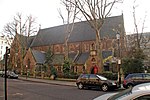Kynance Mews

Kynance Mews is a mews street in South Kensington district of the Royal Borough of Kensington and Chelsea in London, SW7. The mews consists of 33 residential properties on a setted road that passes from Gloucester Road on the east, before being bisected by Launceston Place, with the western end of the mews ending in a cul-de-sac. The entrances to the mews pass through three arches, each listed Grade II on the National Heritage List for England. The arches were built c. 1860 to a design by Thomas Cundy III.David Tucker in his 2009 book London Walks: London Stories wrote that Kensington is home to the "prettiest and most unusual" mews, and that Kynance Mews was the mews for those who want "sheer rustic rose-petal-perfect-pretty". In their 1982 book The Mews of London, Barbara Rosen and Wolfgang Zuckermann wrote that upon entering the western end of the mews from Launceston Place, "one can easily forget London and imagine oneself in a village deep in the English countryside". The mews is a popular place for Instagram photographs; having been described as "Insta-famous" and has been listed as one of the most "instagrammable" places to photograph wisteria in London by the Evening Standard.
Excerpt from the Wikipedia article Kynance Mews (License: CC BY-SA 3.0, Authors, Images).Kynance Mews
Kynance Mews, London South Kensington (Royal Borough of Kensington and Chelsea)
Geographical coordinates (GPS) Address Nearby Places Show on map
Geographical coordinates (GPS)
| Latitude | Longitude |
|---|---|
| N 51.497363888889 ° | E -0.18561944444444 ° |
Address
Kynance Mews 20
SW7 4QW London, South Kensington (Royal Borough of Kensington and Chelsea)
England, United Kingdom
Open on Google Maps









